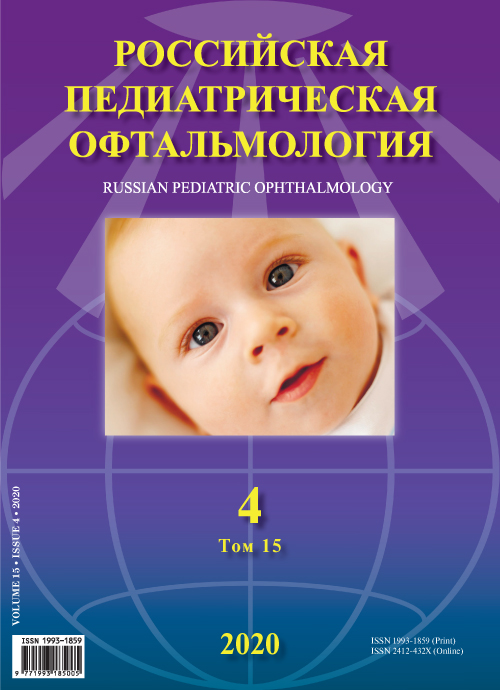卷 15, 编号 4 (2020)
- 年: 2020
- ##issue.datePublished##: 15.12.2020
- 文章: 4
- URL: https://ruspoj.com/1993-1859/issue/view/3604
- DOI: https://doi.org/10.17816/rpoj.2020.15.4
Clinical studies
Analysis of retinoblastoma incidence in children
摘要
Purpose. Compare the staging of retinoblastoma (RB) at the initial presentation according to the TNM classification in the periods 1994-1998 and 2004-2008.
Methods. 332 patients with RB were included in a retrospective study. The patients were examined and treated in the periods from 1994 to 1998 (n=162, group 1), from 2004 to 2008 (n=170, group 2). Monolateral RB in group 1 was diagnosed in 73.5% of cases (n=119), bilateral RB - in 26.5% (n=43). Monolateral RB in group 2 was diagnosed in 64.7% of cases (n = 110), bilateral RB - in 35.3% (n=60).
Results. There was no difference between the groups in the frequency of T1 and T2 stages. Monolateral stage T3 RB was detected in group 1 in 47.9% of cases, which is significantly less than in group 2 - 93.6% (p=0.0001). Monolateral stage T4 with RB was diagnosed in 47.9% of eyes in group 1, which is significantly more frequent than in group 2 - 3.6% (p=0.0001). Bilateral stage T3 RB in group 1 was detected in 61.6% of eyes, which is significantly less than in group 2 - 80% (p=0.004). Stage T4 in group 1 was diagnosed in 20.9% of eyes, which is significantly more frequent than in group 2 - 0.8% (p=0.0001). The most common stage was T3.
Conclusions. Analysis of the morbidity structure in children with primary retinoblastoma showed that, thanks to the introduction of new diagnostic technologies, in the second period, the amount of extrabulbar growth significantly decreased. At the same time, the frequency of children admitted in the early stages remains low, and intraocular retinoblastoma of stage T3 remains the most common in both binocular and monocular forms. Despite this, the introduction of new treatment technologies has made it possible to expand the indications for organ-preserving treatment.
 5-10
5-10


Safety assessment of the modified evisceration technique in posttraumatic pathology of the eyeball
摘要
Objective: to assess the safety of evisceration in comparison with enucleation in post-traumatic eyeball pathology.
Methods: 153 patients were examined, from 2016 to 2019, with the outcome of the injury (including surgical), followed by morphological examination of 153 distant eyes of the above patients. Patients are divided into two groups, based on the type of surgical intervention. Group I consisted of 34 patients (34 eyes), the removal of which was carried out by enucleation. Group II included 119 patients (119 eyes), the removal of which was carried out by the method of evisceration according to the developed technique.
Results: Morphological analysis of 34 distant eyes of group I patients by enucleation revealed inflammatory changes in the immune nature in 26 (76.4%) eyes. In a morphological analysis of the removed material of group II (119 removed eyes by the method of evisceration), microscopically, in 31 (26%) cases we observed the phenomena of traumatic uveitis with signs of immune inflammation. In all other microscopically examined eyes, changes characteristic of the outcome of an eyeball injury were observed: the prevalence of fibroblastic processes, the formation of gross fibrotic changes in the eye cavity and, as a result, tractional retinal detachment.
Conclusion The results of the study on large clinical material indicate that with modern evisceration technology with coagulation of emissaries and excision of the inner layers of the sclera, there is practically no risk of CO after it, and the cosmetic and functional result is higher than with enucleation.
 11-18
11-18


Clinical recommendations
Eye diseases in children for which yag-laser reconstructive interventions are effective
摘要
Based on many years of experience in laser ophthalmosurgery in children (from 1991 to 2019, 5376 YAG laser reconstructive surgeries were performed in children aged 2 months to 17 years in the department of eye pathology in children of the Federal State Budgetary Institution "Helmholtz NMRCED(MRI)GB", improvement of laser technologies (traditional laser techniques are adapted for children, 14 proprietary techniques are patented), an expanded and detailed list of eye diseases in children has been developed and illustrated for practical pediatric ophthalmologists, for which YAG-laser reconstructive interventions are effective, for implementation into clinical practice of pediatric ophthalmology in the Russian Federation.
 19-26
19-26


Reviews
Cystoid macular edema associated with retinitis pigmentosa: clinic, diagnostic, treatment approaches
摘要
Retinitis pigmentosa (RP) is a genetically determined degenerative retinal disease characterized by primary progressive degeneration of rod and secondary degeneration of cone photoreceptors. Despite the fact that the central retinal zone remains relatively intact for a long time, the most common complication of RP is macular edema (ME). The causes of ME in patients with RP have not been finally established, and treatment approaches are controversial. This article presents the modern data on the pathogenesis, clinical aspects, diagnostic, and treatment methods of ME associated with RP.
 27-36
27-36











